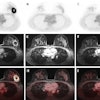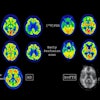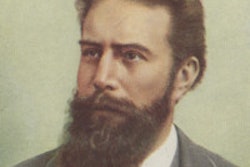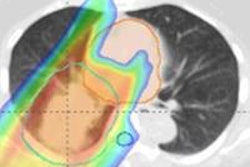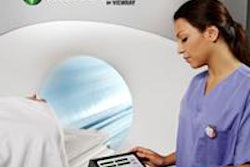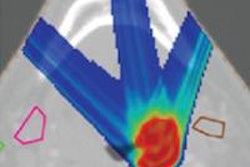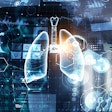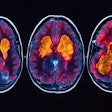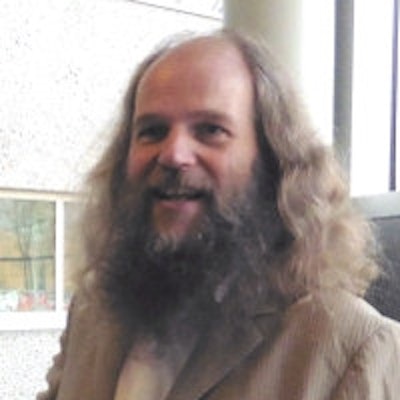
At the end of February, the Netherlands Cancer Institute (NKI) in Amsterdam hosted a farewell symposium for esteemed medical physicist Marcel van Herk, PhD. The symposium, organized by Dr. Marcel Verheij, PhD, chair of NKI's radiotherapy department, saw a panel of colleagues and collaborators discuss van Herk's many scientific breakthroughs and achievements. In a series of lively presentations peppered with anecdotes and photographs, the speakers shared their experiences of working with van Herk during his 32 years at NKI.
Van Herk is taking up a position at the University of Manchester, based at the Christie Hospital site. At the farewell symposium, which also featured a "museum" of his early designs and devices, around 150 attendees assembled to hear about van Herk's pioneering work in the fields of electronic portal imaging technology and cone-beam CT (CBCT)-guided radiotherapy.
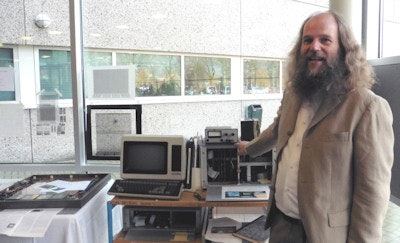 Marcel van Herk with some of his early computing kit and devices.
Marcel van Herk with some of his early computing kit and devices.With around 190 published research papers to his name, one of van Herk's earliest achievements was the creation of the first compact electronic portal imaging device (EPID) in 1983. A six-channel prototype was shortly followed by a 30-channel version, and in 1986 the first clinical images were created using a 128 x 128 pixel, 32 x 32 cm EPID based on liquid filled ionization chambers.
"These early portal images were revolutionary and made a huge impact in the field," said James Balter from the University of Michigan. Balter highlighted van Herk's work on the concepts of radiotherapy margins and uncertainties, including the development of the "van Herk formula" in 1998. This formula -- a margin recipe to ensure that 90% of patients receive 95% of the prescribed target dose -- incorporates both random and systematic errors. The recipe has since been refined, but has stood the test of time and is still in use today.
More recently, van Herk showed that incorporating uncertainties into the treatment plan optimization process can lead to a better therapeutic ratio than using margins. "Marcel critically changed the way we view variability and its impact on radiotherapy," Balter said. "He will impact the field for years to come."
CBCT collaborations
The next speaker -- NKI's Jan-Jakob Sonke -- first met van Herk in October 2000 whilst being interviewed for a job at NKI. "Marcel is one of the brightest people on earth," he told the audience. Sonke's first project involved looking at focal spot motion, but he said that the really exciting times began when they started to work on CBCT.
Kevin Brown, Elekta's global vice president of scientific research, explained how van Herk helped translate the concept of CBCT guidance into a clinical product. Brown described the formation of the Synergy consortium in 2000, with the aim of using CBCT for image-guided radiotherapy (IGRT). This project saw Elekta supply an IGRT research system (which would later become the Elekta Synergy) to each of four collaborators: Christie Hospital in the U.K., William Beaumont Hospital in the U.S., Princess Margaret Hospital in Canada, and NKI.
In July 2003, NKI's system produced its first images. At that stage, however, there was still a lack of effective clinical software. So at the next Synergy consortium meeting, van Herk presented his high-speed CBCT reconstruction and registration software, and the first prototype of the XVI (x-ray volumetric imaging) software was born. "The mindset of thinking about image guidance, rather than just imaging, was key to development of CBCT," Brown said.
The next speaker, Ben Mijnheer, provided an overview of van Herk's achievements from the instigation of electronic portal imaging at NKI, to van Herk's development of sophisticated clinical software to the QUIRT (real-time imaging and quality control in radiation therapy) project. Mijnheer, a clinical physicist at NKI, also described van Herk's studies on intra- and interobserver variability in contouring CT images. This work revealed that training and peer collaboration could lead to considerable improvements in the reproducibility of target volume definition.
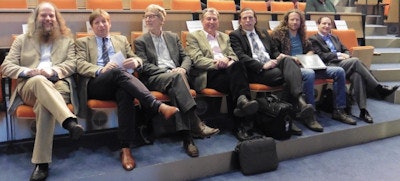 Symposium speakers (left to right): Marcel van Herk, Marcel Verheij, Ben Mijnheer, Kevin Brown, David Jaffray, Jan-Jakob Sonke, and James Balter.
Symposium speakers (left to right): Marcel van Herk, Marcel Verheij, Ben Mijnheer, Kevin Brown, David Jaffray, Jan-Jakob Sonke, and James Balter.Liquid networks
David Jaffray, from the Techna Institute and Princess Margaret Hospital, first met van Herk in a hot tub -- an encounter that led to many years of fruitful collaborations on CBCT. "The idea of imaging on the treatment machine, without moving the patient was very exciting," he said.
Jaffray, also a member of the Synergy consortium, highlighted van Herk's sterling efforts in software development. He told the audience about a grant proposal that he was writing in 1999, on the use of kilovoltage CBCT for image-guided prostate radiotherapy. The proposed system had an image acquisition time of less than 2 minutes and a reconstruction time of less than 5 minutes. But in a radiotherapy department treating 30 patients per day, this totaled too much additional time. The image analysis needed to be faster, simpler, and more automated.
Jaffray discussed this problem with van Herk, who was about to board a transatlantic flight. "Marcel said he'd try to get something working on the plane." And in a seven-hour flight, working on a small laptop, van Herk developed a progressive matching scheme (which matches bone and then soft tissue) for automated prostate detection and determination of shifts between the planning CT and the CBCT. "We couldn't have won the grant without Marcel," Jaffray said.
Jaffray emphasized the importance of collaboration and connectivity within research developments. "The science was great, but the best part was the people," he said. "Marcel has inspired a generation of medical physicists, therapists, and clinicians."
The symposium continued with a speech by NKI's director of organization and management Wim van Harten, who presented van Herk with a copy of a microscope designed by Antoni van Leeuwenhoek, after whom NKI's hospital is named. Next up was a somewhat boisterous quiz, in which the audience were shown scenarios and invited to guess "what Marcel said/did next."
 Wim van Harten presents Marcel van Herk with a copy of an Antoni van Leeuwenhoek microscope.
Wim van Harten presents Marcel van Herk with a copy of an Antoni van Leeuwenhoek microscope.Looking back, and forward
Finally, van Herk took to the podium, and attempted to summarize more than 32 years' of work in 30 minutes. He explained how his interest in science began at a young age, with the dismantling and rewiring of equipment found in scrap yards to build his own computer. During his physics studies in the early 1980s, a bad experience at an antinuclear power demonstration prompted him to move from high-energy physics to medical physics.
And in September 1982, van Herk was enticed to work at NKI by a "very interesting proposal to build the first flat EPID to replace x-ray film for checking radiotherapy" as well as by the presence of an active computer development group.
After completing his PhD in early 1992, van Herk spent six months in the U.S., working at Harvard Medical School on CT/MR image fusion. He returned to NKI -- notably without sporting the clean-shaven, short-haired look predicted by some colleagues -- where he remained since. For the last 10 years, he has also held a part-time teaching role as a professor at the University of Amsterdam.
The Christie National Health Service (NHS) Foundation Trust is part of the Manchester Cancer Research Center (MCRC), the largest cancer treatment center in Europe, and is one of two sites chosen for the U.K.'s forthcoming implementation of proton therapy. The Christie/MCRC is also a member of the research consortium currently working on the commercial release of Elekta's Atlantic MRI-guided radiotherapy system. Without a doubt, we'll be hearing plenty more from van Herk in years to come.
© IOP Publishing Limited. Republished with permission from medicalphysicsweb, a community website covering fundamental research and emerging technologies in medical imaging and radiation therapy.


